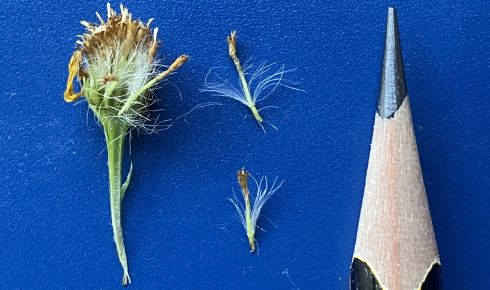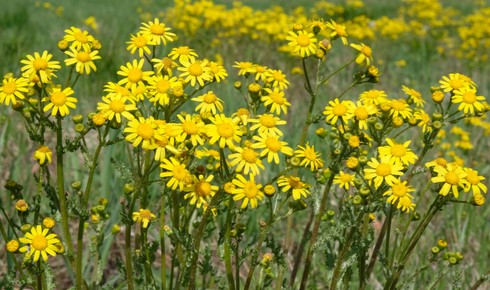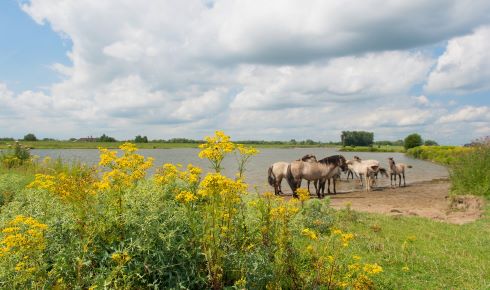Deadly daisies?

September 11th 2023
Is ragwort a toxic, invasive weed or an ecologically important and harmless wildflower? Ecologist and farmer Professor Gordon Maxwell FRSB explores this ubiquitous plant in search of an answer
To some people ragwort is an annual daisy producing beautiful golden flowers, a source of food for pollinators and ‘an important part of our natural heritage’1. To others it has medicinal properties, while many believe it is an aggressive, invasive weed, poisonous to farm animals and far too dangerous to be used in medicine.
What is clear is that a better understanding of its biology can help those who look after livestock, horses or rural land better manage this plant, and can also put paid to any misconceptions that the toxic alkaloids in ragwort are harmless natural products safe for human use.
Ragwort’s commonness and reputation has led to it being known by a variety of names, including stinking willy, stinking nanny, staggerwort, golden ragwort, common ragwort, tansy ragwort, tansy butterweed, stammerwort, fireweed and mare’s fart. I am sure that this list is not exhaustive – and these are just the English names: we find more in French, Spanish, German and African languages.
In countries where cattle grazing is economically important, such as the US, UK, Canada, Australia, South Africa, Brazil and New Zealand, this plant is typically designated as just ragwort. The binominal Senecio jacobaea will be used here, although the plant has, in recent years, been redesignated as Jacobaea vulgaris2.
Genetically flexible
As might be expected with a plant that is so widespread, the exact taxonomy lacks precision and worldwide some 1,000 species within the genus Senecio have been attributed to this member of the sunflower family2. Like many daisy-type sunflowers, ragwort has impressive genetic flexibility that enables it to adapt to the wide range of environments that it encounters globally. This phenotypic flexibility, resulting in many varieties or ‘ecotypes’, can challenge the tidiness of the species concept3.
 Ragwort has an extraordinary ability to adapt to different conditions around the world, reflected in a number of different 'eco-types' that may or may not be identified as distinct species.
Ragwort has an extraordinary ability to adapt to different conditions around the world, reflected in a number of different 'eco-types' that may or may not be identified as distinct species.
Botanical features
Senecio jacobaea has a variety of botanical features that contribute to its success. Its prolific, floret-laden, stem-like inflorescence has a variable maturation rate, ensuring a steady release of seeds. Fast germination exploits population expansion opportunities when the environment is favourable, and slow or delayed germination is used when the ideal season fades.
The florets are arranged in clusters (capitula) with up to 200 florets per capitula. Often around 100 capitula may be found on the inflorescence, yielding tens of thousands of florets. Even if only 1% of these florets succeed in producing seeds, one ragwort can generate 2,000 seeds – a fantastic reproductive potential.
The abundant, light seeds equipped with barbed pappus hairs adapted to exploit both wind and cattle hair are readily dispersed. These seeds are capable of remaining viable in the soil for up to eight years2.
Ragwort establish as ground-hugging vegetative rosettes. While many rosettes may be uprooted by cattle foraging, if just one rosette becomes a mature plant, it can result in takeover by ragwort, as the spreading rosette prevents other grasses from establishing. Indeed, due to the unusual anatomical attributes of ragwort rosettes, vegetation disturbance can actually help the ragwort form new buds – seedlings or rosettes that may appear to be damaged by cattle hoof action simply favour ragwort survival.
Further, the ragwort root system is capable of regeneration following cutting or partial uprooting. Finally, the stem and leaves release an unpleasant smell when crushed, which may help deflect grazing attempts by herbivores but, equally, attract insect pollinators.
Grim to graze on
The odorous and unpleasant-tasting ragwort pyrrolizidine alkaloids (PAs) deter cattle from grazing on ragwort in certain feeding situations. However, some recent research on dairy cattle has demonstrated that in more intensive dairy farms, where cattle numbers reach five cows per hectare and more, dominance behaviours may force animals lower in the hierarchy to eat less-preferred herbage4,5,6,7, such as ragwort. I have observed on numerous occasions cattle taking ragwort inflorescences despite them having concentrations of PAs “30-fold higher than in the vegetative plant tissues”8. The assumption that the production of these compounds is an effective herbivore defence strategy perhaps warrants re-examination.
The depiction of ragwort by some groups as a harmless wildflower is also something that needs to be examined. In their 2016 briefing1 the Friends of the Earth UK branch concluded that: “common ragwort is an ecologically important wildflower native to the UK, Europe and Asia, which seems to arouse strong views”. The briefing aimed to correct what they claimed were misconceptions about ragwort and highlight its importance to pollinators – arguing that over 80 invertebrate species use the plant as a food source and 35 insects are dependent on it. The briefing argued that proven horse poisoning incidents are rare; that livestock don’t generally live long enough to develop symptoms of poisoning; and that the control of the plant, which is often misidentified, leads to other plants being destroyed.
 Ragwort poisoning is a particular concern for horse owners
Ragwort poisoning is a particular concern for horse owners
However, a 2007 Defra report suggested that up to 500 horses had died in a single year from ragwort poisoning9. While it is true that cattle are often slaughtered before ragwort poisoning becomes evident, Bondan et al (2005)10 record that in the southern region of Brazil 50% of cattle deaths due to toxic plants were caused by Senecio sp. The book Biology and Biological Control of Tansy Ragwort2 set out in detail the cumulative and irreversible liver damage to cattle, horses, goats and deer caused by ragwort.
Use in medicine
In terms of ragwort and human exposure, an extensive review of herbal medicine containing PAs by Neuman et al11 reports liver poisoning caused by medicines containing PAs from Senecio sp, including S. jacobaea. Senecio sp feature in Chinese medicine to treat conditions such as febrile diseases, enteritis and hepatitis. There is a long historical foundation to these medicines, which are generally prescribed for short periods, not for sustained use.
A central concern in these medicines is that up to seven different PAs, with varying levels of toxicity, may be produced in different amounts by ragwort under different ecological conditions. One PA, senecionine, has caused limb paralysis in horses.
Acute poisoning due to the use (misuse really) of traditional herbal medicines has been reported. The Neuman group cite a range of papers reporting fatalities in children in South Africa and outbreaks of conditions such as hepatic veno-occlusive disease in Afghanistan. It is very likely that socioeconomic factors sit at the basis of these cases, as advanced medicine may not be available or affordable. In Germany the national health bureau warned of the dangers of natural products, such as honey made from S. jacobaea nectar, which contain significant PA levels.
Reining in ragwort
From the huge infestations of the 1970s (including one estimated to cover 3.6 million hectares in Oregon, US), to the debates around poisonings today, ragwort is clearly a plant that needs to be studied.
In the US and New Zealand especially, there is a growing awareness of the wisdom of avoiding the ecotoxicological ramifications of weed control herbicides. However, the use of sheep, which browse ragwort at the rosette stage when PAs are in lower concentrations than in a plant in full bloom, has faded as a biocontrol agent due to concerns around bioaccumulation in and contamination of meat. Insects such as the cinnabar moth (Tyria jacobaeae) and the tansy ragwort flea beetle (Longitarsus jacobaeae) have been trialled as biocontrol agents in both the US and New Zealand, but this idea remains a work in progress.
Clearly, there are at least two sides to the ragwort story. This daisy once had a place in the natural vegetation of the UK and Europe, Siberia and Asia, but as so many ecological studies have shown, biodiversity in the wrong place can create ecological insults and conflicts with people and their animals.
To advocate that citizens in all sectors of society in the UK should look upon ragwort as just a native plant with an unwarranted bad name undermines the global research and efforts to handle this challenging herb.
Perhaps if ragwort attracts more research due to the pharmacological potential of specific alkaloids11 – which can perform biochemical jobs such as inducing mitochondrial toxicity in pathogens that threaten people and domestic animals – there may be future uses for ragwort-derived compounds in medical and veterinary science.
Likewise, ragwort research would benefit from a big dose of taxonomy and injections of chemical ecology aimed at tracing the dynamics of PAs as they move up the food chain from herb, to honey, to human. Indeed, there are many features of ragwort biology, and the interesting debates around it, which make this daisy an excellent theme plant for study by school students or undergraduates.
Professor Gordon Maxwell FRSB lives and works in New Zealand (Waikato region) and Hong Kong where he sustains drystock cattle farming and part-time university connections.
1) Ragwort: Problem plant or scapegoat? Friends of the Earth Briefing, November 2016.
2) Winston, R. et al. Biology and Biological Control of Tansy Ragwort (Forest Health Technology Enterprise Team (FHTET) USDA, Montana State University and University of Idaho, 2022).
3) Maxwell, G. S. Kandelia candel and ‘Kandelia obovata’: ecotypes, varieties or different species? Mangrove Science 4(5), 31–40 (2007).
4) Beilharz, R. G. & Zeeb, K. Social dominance in dairy cattle. Appl. Ethol. 8(1/2), 70–97 (1982).
5) Sottysia, K & Nogaiski, Z. The effect of social hierarchy in a dairy cattle herd on milk yield. Pol. J. Nat. Sci. 25(1), 22–23 (2010).
6) Maxwell, G. S. Avicennia marina foliage as a salt enrichment nutrient for New Zealand dairy cattle. ISME/GLOMIS Electronic Journal 1(8), 22–24 (2012).
7) Hussein, A. N. Effects of social dominance on milk production and grazing behaviour of lactating dairy cows. PhD thesis. Lincoln University, Canterbury, New Zealand (2019).
8) Hartmann, T. and Zimmer, M. Organ specific distribution and accumulation of pyrrolizidine alkaloids during the life history of two annual Senecio species. J. Plant Physio 122, 67–80 (1986) & Hartmann, T. Chemical ecology of pyrrolizidine alkaloids. Planta 207(4), 483–495 (1999).
9) Defra (2007). Code of Practice on How to Prevent the Spread of Ragwort (cited in FOE Briefing, November 2016, p3).
10) Bondan, C. et al. Oxidative stress in the erythrocytes of cattle intoxicated with Senecio sp. Vet. Clin. Pathol. 34(4), 353–357 (2005).
11) Neuman, M. et al. Hepatotoxicology of pyrrolizidine alkaloids. J. Pharm. Pharm. Sci. 18(4), 825–843 (2015).


